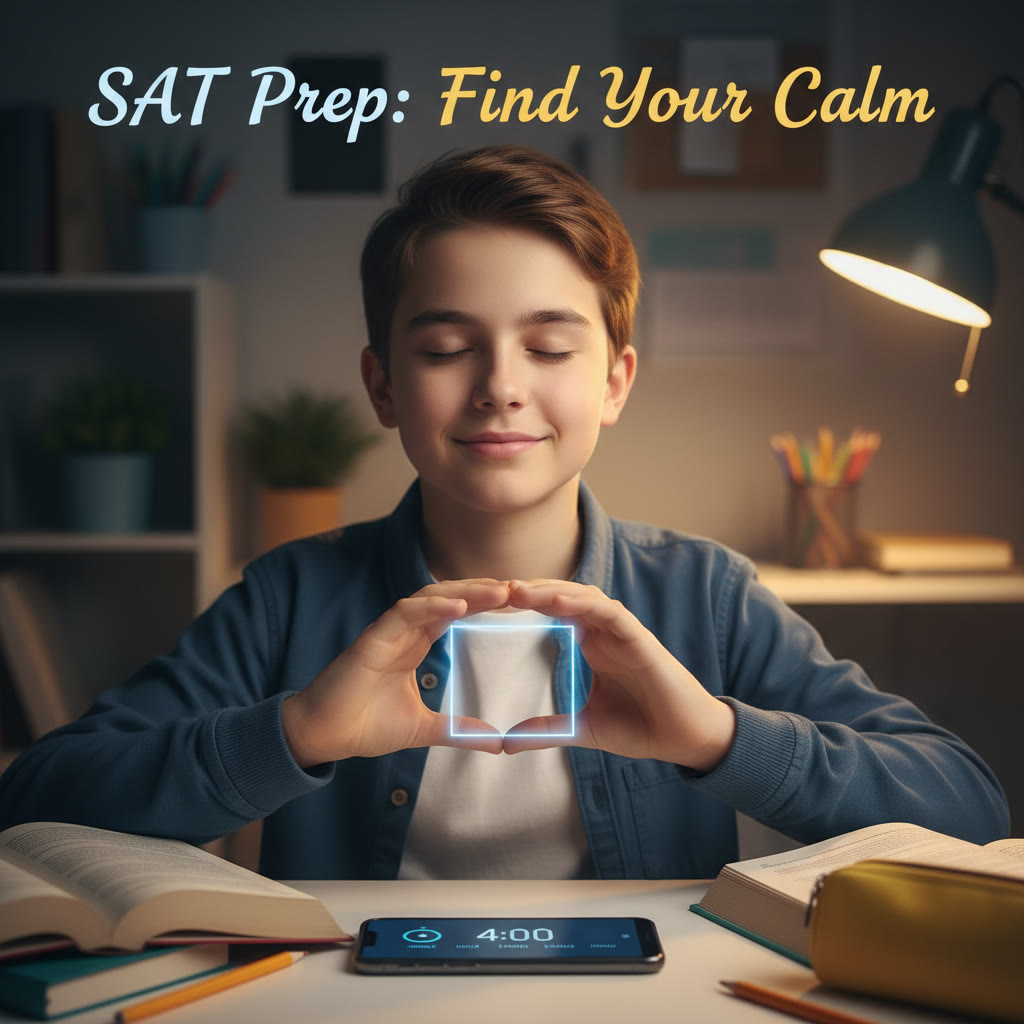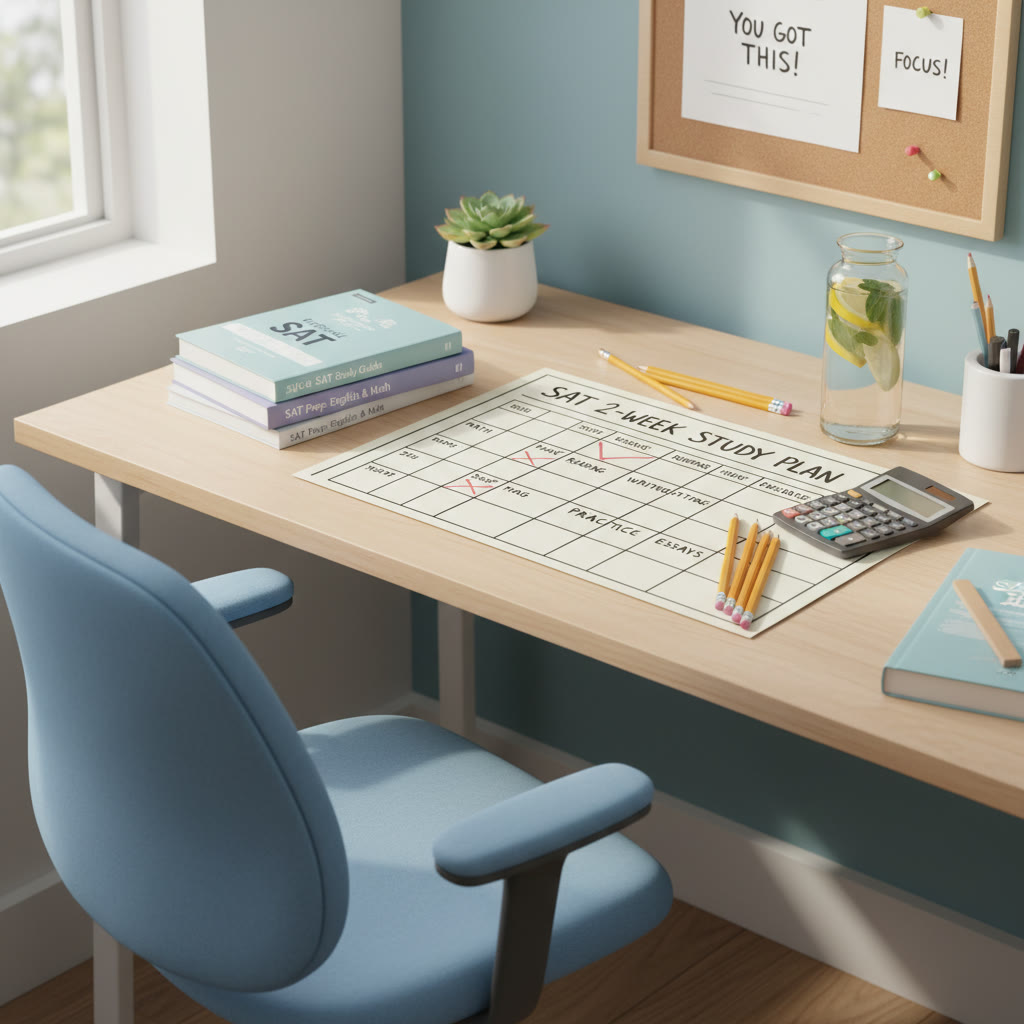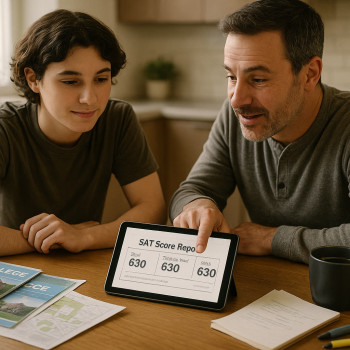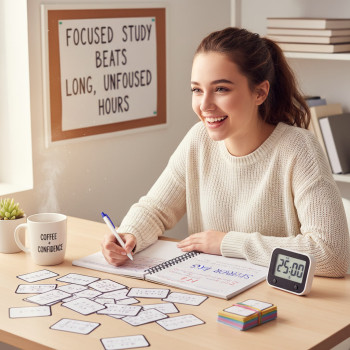Why Test Anxiety Happens and Why It’s Fixable
Walk into any quiet library or crowded classroom and you’ll find students who know the content but still feel their chest tighten at the thought of the SAT. Test anxiety is not a sign of weakness or a reason to panic; it’s a normal human response when high stakes meet pressure and uncertainty. The body reacts as if it faces a real threat, releasing stress hormones that sharpen some skills but often cloud reasoning, disrupt memory retrieval, and shrink working memory.
Here’s the good news: anxiety is a response, not a destiny. With the right strategies — practical, evidence-based, and tuned to how you personally work — you can reduce the physiological and mental grip of worry and perform closer to your true ability on test day.
A practical roadmap: what this blog will give you
- Concrete mindset shifts that change how anxiety shows up.
- Daily and weekly study habits that build calm confidence.
- Physical, breathing, and visualization tools to use before and during the test.
- A sample 2-week plan and a quick-reference table of calming techniques.
- How 1-on-1 support — like Sparkl’s personalized tutoring — can integrate into your plan to make everything more effective.
Mindset shifts that make the rest possible
Before tactics, update your narrative. Replace thoughts like I have to get a perfect score with I will prepare well and do my best. This subtle reframe reduces catastrophic thinking and focuses you on process rather than impossible outcomes.
Accept some nerves
Nerves can actually help. A small amount of arousal improves alertness. Tell yourself that a little nervousness is a sign you care and that you have practical tools to channel it. Acceptance reduces the secondary panic of worrying about being anxious.
Break the score into behaviors
Scores look static; behaviors are changeable. Translate goals into actions: complete three full practice tests, review missed problems within 48 hours, practice timed sections twice a week, and get 8 hours of sleep consistently. Tracking behaviors gives you control and steady improvement.
Build confidence with deliberate practice
Confidence isn’t luck — it’s earned through repeated, focused practice. But all practice is not equal. Quality matters more than hours logged.
Practice smart: focus on high-leverage activities
- Take full-length, timed practice tests every 7–10 days to build stamina and predictability.
- Use short, targeted sessions (25–50 minutes) to sharpen weak areas; avoid marathon rereads that feel productive but don’t build skill.
- Analyze mistakes: label each miss as careless, conceptual, or timing-related. That diagnosis directs efficient work.
- Simulate testing conditions: same time of day, same quiet space, only allowed breaks and materials. Familiarity reduces uncertainty.
How tutoring accelerates calm confidence
One-on-one support changes the equation. A skilled tutor helps you pinpoint patterns in errors, offers tailored drills, and provides real-time feedback. Sparkl’s personalized tutoring blends expert tutors with AI-driven insights to create tailored study plans and focused sessions that target your exact gaps. That focused progress reduces the fuzzy feeling of being behind and replaces it with steady competence — the best antidote to anxiety.
Daily habits that lower baseline anxiety
Anxiety is easier to manage when your baseline physiology is steady. Small, daily habits compound into a calmer nervous system and clearer thinking.
- Sleep: Aim for consistent 7.5–9 hours nightly. Avoid late-night cramming; memory consolidation happens during sleep.
- Movement: 20–45 minutes of aerobic activity 3–5 times a week improves mood and cognitive flexibility.
- Nutrition: Favor complex carbs, lean protein, and healthy fats. On test day, choose a breakfast that sits comfortably in your stomach and provides steady energy.
- Hydration: Even mild dehydration impairs focus. Keep a water bottle on hand while you study and during breaks.
- Micro-breaks: Use the Pomodoro method or brief walks to avoid burnout during long study days.
Simple breathing and grounding techniques you can use anywhere
When anxiety spikes, physical techniques interrupt the stress response quickly. These are safe, easy, and portable.
Box breathing (4-4-4-4)
Inhale for four seconds, hold for four, exhale for four, hold for four. Repeat 4–6 times. This pattern slows the heart rate and brings attention into the present.
5-4-3-2-1 grounding
Identify 5 things you can see, 4 you can touch, 3 you can hear, 2 you can smell, and 1 you can taste. This pulls attention away from future worries and into immediate sensory input.
Gentle progressive muscle release
Tense and then relax muscle groups from feet to face. Doing this for 3–5 minutes reduces bodily tension and resets breathing.
When to use each tool: a quick reference table
| Situation | Immediate tool (0–2 minutes) | Short practice (5–15 minutes) |
|---|---|---|
| Sudden panic before a section | Box breathing, grounding | One-minute progressive muscle release; reframe negative thought |
| Low confidence after a practice test | Walk and breathe | Analyze 5 mistakes, plan targeted practice |
| Restless night before | Relaxing breathing and light reading | Warm shower, early bedtime, avoid screens |
Two-week sample plan to build calm momentum
This plan assumes you have a baseline of content knowledge and want a focused run-up to the exam. Tweak it for your schedule.
| Day | Focus | Session |
|---|---|---|
| Day 14 | Diagnostic and pacing | Full practice test under timed conditions; note pacing and question types missed |
| Day 13 | Targeted review | Review missed problems; create a corrective drill set |
| Day 12 | Section practice | One timed reading and one timed math section; practice breathing between sections |
| Day 11 | Content repair | 30–50 minutes on weakest topic; tutor check-in if available |
| Day 10 | Stamina and focus | Half-length test; analyze timing errors |
| Day 9 | Strategy and process | Practice elimination techniques for multiple choice; practice grid-in strategy |
| Day 8 | Full-length test | Simulate test day exactly; review afterwards |
| Day 7 | Recovery and light review | Go over major mistakes; try relaxation routines |
| Day 6 | Targeted practice | Two focused sessions on different weaknesses |
| Day 5 | Timed sections | Practice tough sections under time |
| Day 4 | Strategy rehearsal | Practice pacing and question triage |
| Day 3 | Light review and relaxation | Short review; visualization and breathing practice |
| Day 2 | Logistics and sleep | Pack materials, confirm route, early bedtime |
| Day 1 | Rest and confidence | Light activity, a short review of formulas and easy problems, and a calm evening ritual |
Visualization: rehearse success in detail
Champions in many fields use visualization to reduce anxiety. Spend 5–10 minutes imagining the test day in as much detail as possible: waking up, the breakfast, the drive, the registration line, sitting down, opening the booklet, the first question, and how you calmly work through it. Pair that image with steady box breathing. The brain treats vivid rehearsal similarly to real experience, so the actual day feels more familiar and less threatening.
Strategies to use during the test
Start with a small win
On test day, begin with a section or question type you know you can handle. Early success reduces adrenaline spikes and builds momentum.
Use the two-pass strategy
Go through questions and answer what you can with confidence, mark the rest, then return. This prevents ruminating on tough problems that sap time and calm.
Short reset rituals
Between sections, close your eyes for 10 seconds, breathe, and shake out your hands. Small, deliberate resets interrupt negative spirals and preserve focus.
Practical test-day checklist
- Necessary ID and admission ticket or confirmation details.
- Two sharpened pencils, eraser, approved calculator with fresh batteries, and snacks for breaks.
- Comfortable clothes in layers for variable testing room temperatures.
- Arrive early to reduce last-minute rush stress.
What to do if anxiety still shows up
If anxiety spikes despite preparation, remind yourself: the test is a single snapshot, not your worth. Use a breathing technique, visit the table above for an immediate tool, and lean on behavior: answer the next question you know. Small wins accumulate quickly. If anxiety is persistent and severe, speak with a school counselor or mental health professional. Tutoring programs like Sparkl’s personalized tutoring also offer structured practice and one-on-one guidance that reduce uncertainty and help students build a calm, customized strategy.
Why reflection matters after each practice test
Reflection is the bridge between practice and improvement. After a full practice test, don’t just look at your score; analyze patterns. How many questions were timing issues? Which content areas repeated as weak points? How did you feel emotionally during the test? Tracking these patterns reduces ambiguity about what to fix and provides clear, confidence-building progress markers.
Real student vignette: small changes, big results
Consider Maya, who felt completely overwhelmed by test day. She knew the content but froze during timed sections. Her tutor recommended two small changes: implement box breathing during every break and practice two timed math sections per week under simulated conditions. Within four weeks, Maya reported calmer sections, fewer careless mistakes, and a sense of control she had not felt before. Her score rose not because she crammed more facts, but because she managed her nervous system and practiced under pressure.
Final checklist: daily, week-of, and test-day
- Daily: 25–50 minutes focused study, hydration, movement, and 8 hours sleep.
- Week-of: Two full practice tests max, review mistakes, confirm logistics, and limit new content.
- Test-day: Eat a steady breakfast, arrive early, use short breathing resets, and remember to pace yourself.
Closing thought: courage is learned
Calm under pressure isn’t a fixed trait reserved for a few. It’s a skill you build with repeated, mindful practice and the right supports. Start small: a two-week plan, daily breathing practices, and a few simulated tests. If personalized guidance would help you stay accountable and efficient, consider one-on-one tutoring options like Sparkl’s personalized tutoring, which pairs expert tutors with tailored study plans and AI-driven insights to speed progress and reduce uncertainty.
Test anxiety can feel enormous in the moment, but with a plan, steady habits, and a handful of techniques you can use instantly, it becomes manageable. You don’t have to eliminate nerves; you just need to learn how to ride them. Take one small step today, and you’ll find the next one easier.



















No Comments
Leave a comment Cancel